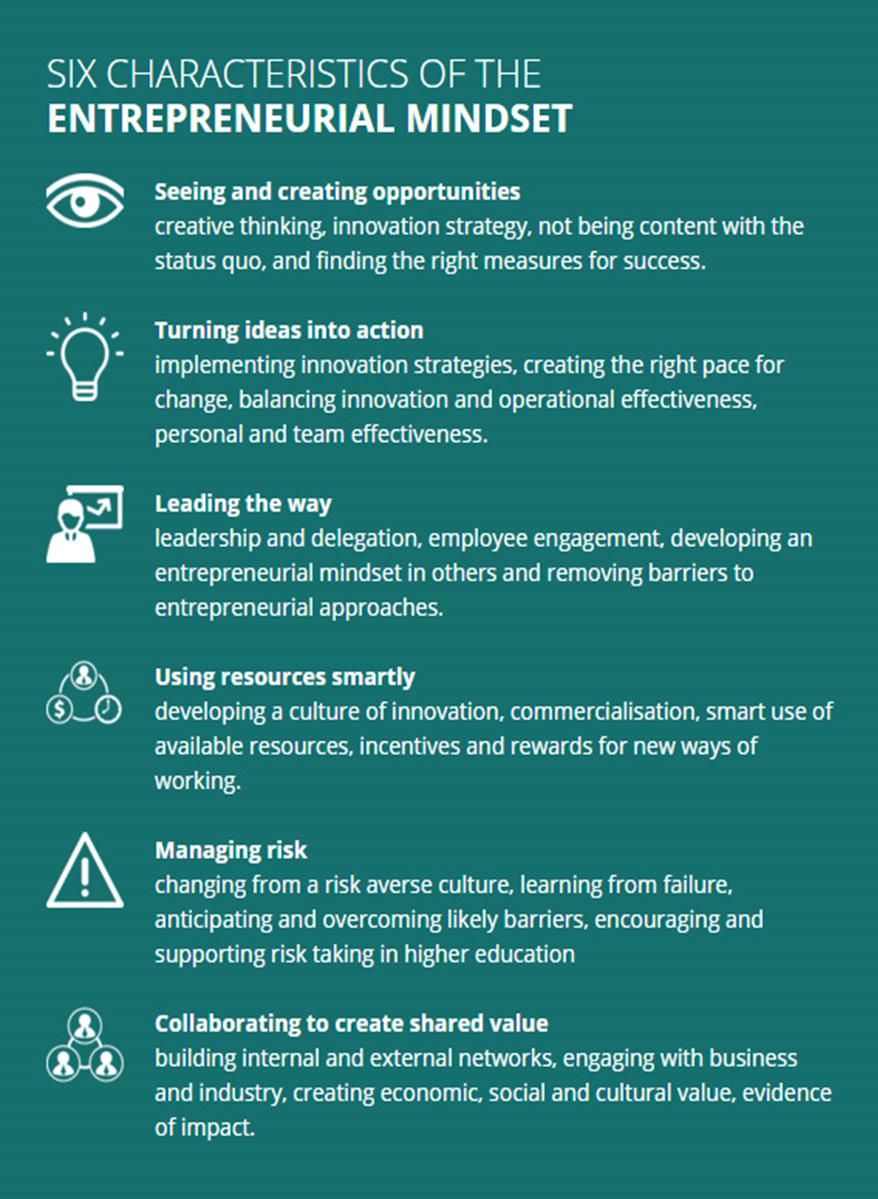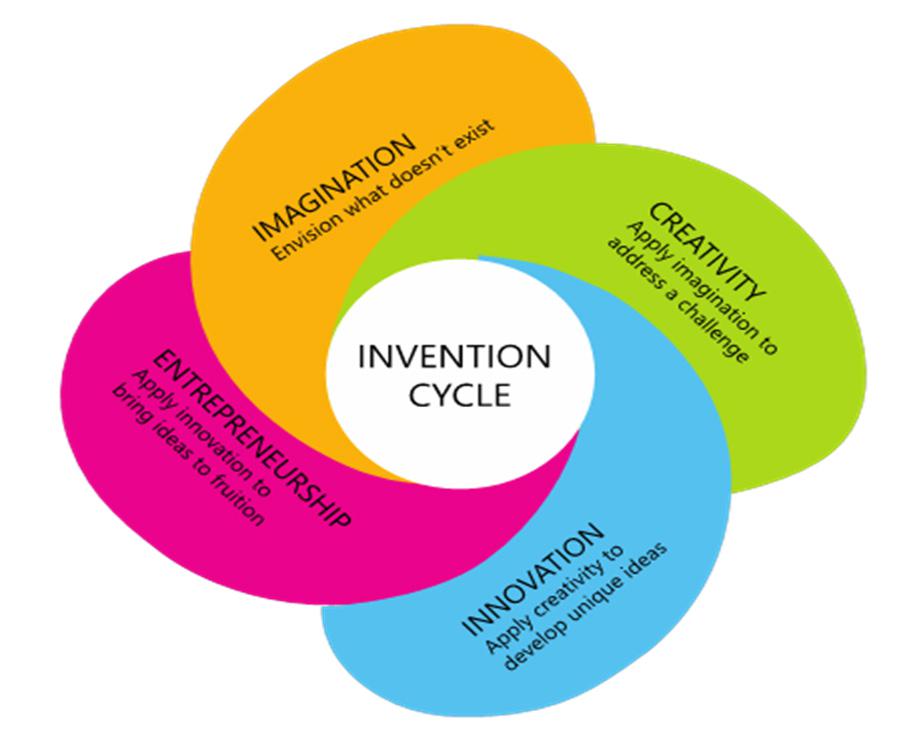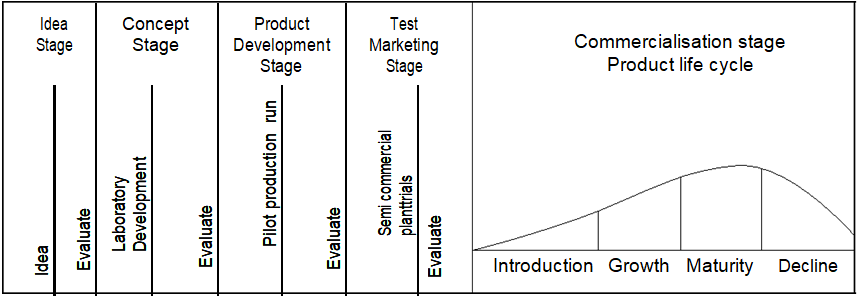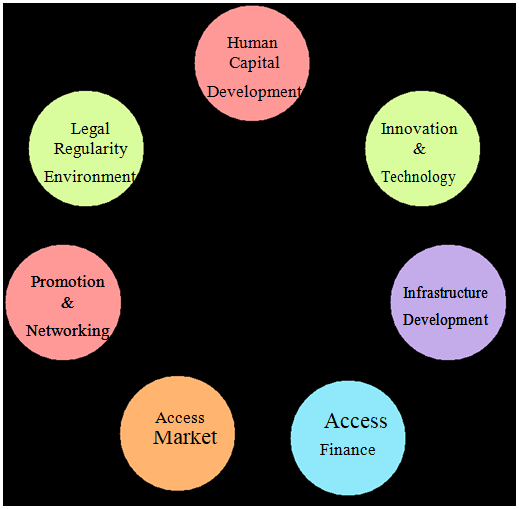The Entrepreneurship Culture
Defining Entrepreneurship
Entrepreneurship is the act of being an entrepreneur, which is a French word meaning “to undertake”. Entrepreneurs find resources and apply innovation, finance and business acumen to transform innovation into economic goods. This may result in new organisations, or it may revitalise mature organisations to seize a perceived opportunity. The most obvious form of entrepreneurship is that of starting new businesses. However, in recent years, the trend includes social and political forms of entrepreneurial activity. When entrepreneurship is describing activities within a firm or large organisation, it is referred to as intrapreneurship, and may include corporate venturing, when large entities spin-off organisations.
The benefits of entrepreneurship to the economy can be summed up in the following concepts:
- Creativity and innovation
- New products, new services, and new business
- Employment generation
- Increase in national income
- Balanced regional development
- Better standard of living
- Dispersal of economic power
- Enhancing welfare amenities
The factors affecting entrepreneurship:
| Internal Factors | External Factors |
| Marketing | Political system |
| Production and technical | Economic system |
| Organisation and management | Socio-economic |
| Financial | Technological |
| Legal | |
| Environment |
Demographic Entrepreneurial Competencies
Are entrepreneurs born or are they made? Certain characteristics are common in successful entrepreneurs, including risk-taking, being achievement oriented, creative, and innovative. The concept of competencies helps in trying to understand entrepreneurial behaviour. At the end of the day, it is the competent individual who manages the process and produces the results.
In 1985, McClelland with McBer & Co had developed an instrument to measure the personal entrepreneurial competencies (PEC), as given below:
Initiative: The entrepreneur should be able to take actions that go beyond his job requirements and to act faster. He is always ahead of others and able to become a leader in the field of business.
See and act on opportunities: An entrepreneur always looks for and takes action on opportunities.
Persistence: An entrepreneur is able to make repeated efforts, or to take different actions to overcome an obstacle that gets in the way of reaching goals.
Seeking information: An entrepreneur is able to take action on how to seek information to help achieve business objectives or clarify business problems.
Concern for high quality of work: An entrepreneur does things to meet certain standards of excellence, which gives him greater satisfaction.
Systematic planning: An entrepreneur develops and uses logical, step by step plans to reach goals.
Efficiency orientation: A successful entrepreneur always finds ways to do things faster or with fewer resources or at a lower cost.
Persuasion: An entrepreneur can successfully persuade or influence others for mobilising resources, obtaining inputs, organising productions and selling his products and services.
Risk-taking: An entrepreneur takes what he or she perceives as moderate risk and states a preference for situations that involve moderate risks.
Self-confidence: A successful entrepreneur has a strong belief in self and his own abilities.
Stages of Entrepreneurial Process
The entrepreneurial process of new ventures comprises all the functions, activity and actions which are necessary for developing the new venture. Basically, it is a process through which a new venture is created by an entrepreneur. The entrepreneur must find, evaluate and develop opportunities by overcoming the forces that resist the creation of something new. The process has four distinct phases. (See table)
| Identify and Evaluate the Opportunity | Develop a Business Plan | Determine the Resources required | Manage the Enterprise |
| Ideation, Opportunity recognition and assessment Creation and length of opportunity Real and perceived value of opportunity |
Title page Table of Contents Executive Summary |
Determine resources needed Determine existing resources Identify resource gapsand available suppliers |
Develop management style Understand key variables for success Identify problem and potential problems |
The Entrepreneurial Culture in Bhutan
Entrepreneurial culture refers to the way in which entrepreneurs behave in establishing industrial ventures. The culture of entrepreneurship in Bhutan is largely viewed as necessity-driven entrepreneurship, rather than opportunity driven — that is, entrepreneurship as a means of survival. Entrepreneurship is viewed as a last resort, as opposed to the pursuit of an opportunity or aspiration.

These limited socio-cultural perceptions about entrepreneurship can result in significant barriers to enterprise, and can undermine the impact of policy to support entrepreneurship. Bhutan started planned economic development with the 1st Five-Year Plan, with the support of India in the early 1960s. Since then, Bhutan has seen successful economic development but having said that, we still lag behind in terms of creative education, which which could diversify economic activities. One way to make an entrepreneurial culture more vibrant is through entrepreneurship education, which plays a major role in economic development.
Entrepreneurship education involves developing the essential attributes of entrepreneurs: Willingness to take calculated risks in terms of time, equity, or career; the ability to formulate an effective venture team; the creative skill to marshal resources; the fundamental skill in building a solid business plan; and finally, the vision to recognise opportunity where others see chaos, contradiction, and confusion (Kuratko & Hodgetts, 2004). Entrepreneurship education has to start from the elementary to the university level, to train creative, innovative and productive citizens, so that we are not left behind.
The elements of entrepreneurial culture are as follows:
- People and empowerment focused,
- Value creation through innovation and change,
- Attention to the basics,
- Hands-on management,
- Freedom to grow and fail,
- Commitment and personal responsibility,
- Emphasis on the future, and sense of urgency.
Creativity and Innovation
Creativity is the seed that enables entrepreneurs to innovate. It precedes innovation, which is a key function in the entrepreneurial process. This invention cycle is defined as applied innovation, innovation as applied creativity, and creativity as applied imagination. Entrepreneurship requires one to inspire imagination in others, resulting in a collective increase in creativity, innovation, and entrepreneurship. This framework allows us to pursue the pathway, describing the actions and attitude required at each step along the way.

Source: Tina Seeliq, Stanford University

Source: Product planning and development process
In the above diagram, an idea gets tested from the idea stage to the commercial stage, to gauge business viability. Recently, the Entrepreneurship Division of the Ministry of Labour and Human Resources started implementing crash courses ideas, like Start-up Weekend, Start-up Innovation Tech week and Hackathon. During this programme, the mentor plays a very important role to materialise the idea into minimum viable products to offer customers. The idea is accelerated for the market.
Entrepreneurship Ecosystem
To develop a vibrant entrepreneurial ecosystem with the “holistic seven key components” is very much needed in Bhutan:
Human Capital Development: Enhancing entrepreneurship education and skill development by building a dynamic ecosystem to nurture creativity, innovation, and entrepreneurship in the country through various entrepreneurship promotion programmes. The Ministry of Labour and Human Resources published a five-year human resources development masterplan for the private sector for both the short and long term. This is expected to help the private sector by developing their employees through various modes of financing.
Infrastructure development: Access to infrastructure and use of existing infrastructure has been always there for start-ups. As most of the limited infrastructure has been continuously used by existing entrepreneurs, the government needs to come up with additional infrastructure, like a business incubation centre and special economic zone to accelerate start-ups.
Technology Exchange and Innovation Adoption: Entrepreneurship, technology, and innovation are mutually supportive. Technology provides entrepreneurs with new tools to improve the efficiency and productivity of their business, or with new platforms on which to build their ventures. In turn, entrepreneurs fuel technological innovation by developing new, or improving existing products, services or processes and ensuring commercialisation. This can be achieved with an incubation centre, digital fabrication laboratory, and research & development facilities.
Access to Finance: Inadequate access to finance remains a major obstacle for many aspiring entrepreneurs. As recent studies confirm, the global financing gap for micro, small, and medium sized enterprises remains enormous. Entrepreneurs of all types require a variety of financial services, including facilities for making deposits and payments, as well as accessing credit, equity, and guarantees.
The central bank, Royal Monetary Authority, launched the Minimum Lending Rate of Interest (MLR), and Priority Sector Lending (PSL), through Financial Institutes like the Bank of Bhutan, Bhutan National Bank, T Bank and Druk PNB. Loden Foundation, a Civil Society Organisation, also came up with funding for those who really need financial support to start their business, with a collateral-free loan. There are other agencies providing support, like Tarayana Foundation, Sabah Bhutan and Bhutan Trust Foundation. Funding support also comes from international agencies like UNDP, UNIDO, Youth Co: Lab, and SAARC Development Fund. Recently, DHI also extended support for the expansion of entrepreneurial businesses by providing Business Acceleration with equity.
Market Access: Access to national and international markets for produce by start-ups is crucial. The most important part of revenue generation for all business activities is marketing. This has to be really taken care of to capture the market. The value chain of marketing has to be complete for the entrepreneur’s products to meet the needs of customers. Some markets which entrepreneurs cannot reach should be facilitated by the government through special incentives or channels.
Optimising legal and regulatory Environment: The boosting of entrepreneurship requires an environment that enables the entrepreneur to create, operate, manage and, if necessary, close a business, within a context where compliance with the rule of law governing disclosure, licensing and registration procedures, and the protection of physical and intellectual property is guaranteed. The regulatory environment should encourage people to set up their own businesses, to try new business ideas, and to take calculated risks, keeping administrative burdens to the minimum, to support public policy and sustainable development objectives. To enable this, the Ministry of Economic Affairs came up with the Economic Development Policy 2016, the Ministry of Finance with Fiscal Incentives 2017, and the National Land Commission with the User Right System. The government introduced G2C to digitise all the licensing system and also online tax filing system.
Promotion and Networking: Network building is an important tool to showcase models, champions, and references for the success of entrepreneurship as a viable, respectable and financially rewarding career option. In developing countries, including Bhutan, the building of the entrepreneurial network is particularly important, for a number of reasons:
- Trust is crucial for doing business in environments with relatively weak systems of contract enforcement. It becomes even more important for start-ups and new entrants that do not yet have established reputations. To the extent that networks are based on particular identities, it is important to strengthen those that are inclusive along professional lines rather than, for example, exclusive based on ethnic or socio-economic lines.
- Inadequate resources for education similarly limits possibilities to advocate entrepreneurship. Networks contribute towards capacity development. This is particularly acute in Bhutan because of the weak capacity building and institutional support for entrepreneurship.
- The digital divide has left youth and communities with inadequate modern communications infrastructure, representing a major impediment to awareness generation on entrepreneurship.
 Source: Entrepreneurship ecosystem
Source: Entrepreneurship ecosystem
Business Planning Process
A business plan is a well-defined written document, based on relevant facts, figures and estimates. It portrays an overall picture of a business proposal, attempts to justify its technical feasibility, market feasibility, financial feasibility, and organisational feasibility as well as commercial success, and also makes clear suggested course of actions in distinguished sections.
The objectives of a business plan are as follows:
- To give directions to the vision formulated by the entrepreneur
- To objectively evaluate the prospects of business
- To monitor the progress after implementation of the plan
- To persuade others to join the business
- To seek loans from financial institutions
- To identify the strength and weakness
- To identify the resources required for the project.
The outline of the business plan is given in annexure 1
Institutional Support for Entrepreneurs
The entrepreneurship development movement is primarily based on the belief that people can accept entrepreneurship as a career. In order to accelerate the speed of the self-employment and entrepreneurship development, various agencies were established by Royal Government of Bhutan, both at central and dzongkhag level.
The term, institutional support system, generally refers to the environment of industry and business, comprising authorities and institutions, whose decisions and operational framework affect the level of business. The institutions include government-owned agencies, statutory corporations and semi-government and autonomous organisations. Currently, there are more than 20 agencies directly and indirectly providing entrepreneurship programmes. With the technical support from the Entrepreneurship Division of the Ministry of Labour and Human Resources, the technical training institutes and zorig chusum institute provide an entrepreneurship programme based on CEFE (Competency based Economies through Formation of Enterprise) methodology, which is action-based. Colleges under the Royal University of Bhutan have entrepreneurship modules for the Gedu College of Business Studies, College of Natural Resources, College of Science and Technology and Jigme Namgye College of Engineering. Other agencies also provide entrepreneurship programmes, like Thimphu Techpark. If more institutes provide entrepreneurship programmes, there will more vibrancy of start-ups. Recently, the SAARC Chamber of Commerce initiated start-up programmes for SAARC countries. There should be strong institutional support on entrepreneurship and start-ups.
International Entrepreneurship Opportunities
International entrepreneurship is a firm level activity that crosses national boundaries, that are necessary to satisfy customers that an entrepreneur targets across countries, involving exporting goods and services, opening sales offices, subsidiaries, manufacturing or joint ventures and the development of business.
The driving forces for an entrepreneur to go to international markets are shown below:
- Attractiveness of foreign markets
- Economies of scale
- Spreading Research and Development costs
- Access to imported inputs
- Marketing opportunities due to life cycles
- Risk spread
- Uniqueness of products or services.
Sourcing the fund
Finance is needed throughout a business’s life cycle. The type and amount of finance required for a business depend on many factors, like the type of business, success of firm, and the state of the economy. There are two main types of money that a business needs, namely capital and current. Capital budgeting is an extremely important aspect of a firm’s financial management. Although capital assets usually comprise a smaller percentage of a firm’s total assets than do current assets, capital assets are long-term.
There are number of sources to raise funds needed for a start-up business, as given below:
- Self-Funding
- Loans
- Grants
- Private angel investors
- Venture capitalists.
The most popular access to finance is self-funding, loans, and grants. Private angel investors and venture capitalists have not set foot in the Bhutanese financial market. In the international financial market, more angel investors and venture capitalists come at the beginning, more than formal banking support for start-ups. It is mostly due to the risks involved at the early stage of a business life cycle.
Managing the Growth
Growth is crucial for entrepreneurial success. Growth is one of the factors that distinguish an entrepreneurial venture from a small business venture. Although growth is a defining feature of an entrepreneurial venture, it does not mean that an entrepreneurial business has the right to grow. It merely means that, if managed the right way, it has the potential to grow. Growth must be an objective and strategy for the venture and it must be managed. Generally, growth refers to increase in a specific parameter during a specific term or period.
The main objectives of growth are:
- Survival of business
- Economies of scale
- Expansion of market
- Owner’s mandate
- Technology driven
- Prestige and power
- Government policy
- Self-sufficiency
In conclusion, the entrepreneurial traits — which are open culture, outcome oriented, team oriented, proactive, networked, open risk-taker, observant, visionary and failure — are important to be successful entrepreneurs. Bhutan needs to develop and inculcate entrepreneurial competencies and culture from an early stage of education, through entrepreneurship education.
Outline of a Business Plan Annexure I
- Introductory Page
- Name and address of business
- Statement of confidentiality of report
- Executive Summary: One to two pages summarising the complete business plan, though it appears in the beginning, but to be written in the last.
- Project at a Glance
- Introduction of business and idea
- Background of business
- Vision, mission and objectives
- SWOT analysis
- Business Model canvas
- Marketing plan
- Future market outlook and trends
- Products and services
- Market Segmentation
- Industry and Market forecasts
- Marketing mix strategy
- Analysis of competitors
- Production and technical plan
- Manufacturing process
- Physical plant
- Machinery and equipment requirement
- Name of suppliers of raw materials
- Organisation and management plan
- Form of business
- Management team background
- Roles and responsibilities of key position holders
- Financial plan
- Total project costs
- Projected Profit and loss
- Projected Cash flow statement
- Projected Balance Sheet
- Ratio Analysis
- Conclusion
- Annexures
